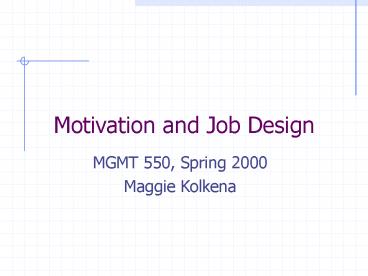Motivation and Job Design PowerPoint PPT Presentation
1 / 24
Title: Motivation and Job Design
1
Motivation and Job Design
MGMT 550, Spring 2000 Maggie Kolkena
2
Check-In
- Learning Application apply the reading to your
world - Rate your job on a scale from 1-10 how well is
your job designed?
3
Objectives
- Review theories of motivation
- Examine elements of job design
- Introduce Socio-Tech design
- Analyze real jobs
- Communication in Virtual Teams
4
How do I motivate my employees?
5
Attribution Theory and Motivation
- Perception is reality
- Managers perceive that one thing or another
motivates an employee - Attribution Theory ones beliefs influence our
actions
6
Theories of Motivation
7
Maslows Hierarchy of Needs
Self-Actualization Needs
Ego/Self-esteem Needs
Social Needs
Security Needs
Physiological Needs
8
Herzbergs Motivator-Hygiene Theory
Factors that contribute to job DISSATISFACTION
Factors that contribute to job SATISFACTION
Hygiene
Motivators
9
Goal Setting Theory
- Locke and Lathams High Performance Cycle
- MBO
10
Rewards and Motivation
- Extrinsic and intrinsic rewards Gainsharing
- Kerr The Folly of Rewarding A While Hoping for B
- Alfie Kohn Punished by Rewards
11
Job Design
12
Cummings and Worley
13
Org Design and Job Design
Environment Customer (needs) Technology
(assets required to compete)
Organization Requirements Strategy (value
proposition, goals) Skills (individual, team
and institutional) -
Task Design Structure (roles, integrating
mechanisms) - Systems (methods, computer systems
etc) - Staff (experts) -
Social Design Style (work habits) Shared
values (beliefs)
14
Background of Socio-Tech
- Tavistock and the Redfield experiments
- TristOrganization Choice
- Davis job centered approach
- Emerged when traditional job design focused more
on the task requirements
15
Socio-Tech
16
Social/Psychological Requirements
17
Technological Requirements
18
Socio-Tech Requirements
- Job Enrichment
- Variety discretion
- Feedback
- Challenge
- Self-Regulating Groups
- Task differentiation
- Task control
- Boundary control
- Traditional Job Design
- Low variety
- Low discretion
- Routinized
- Traditional Group Design
- Specified roles
- External supervision
- Planned interaction
19
Application
- From equal size teams around the worst jobs
- Analyze the job using models from Chapter 4,
Cummings Worley and/or Socio-Tech - Develop recommendations to improve the job
- Present your work
20
Communications Virtual Teams
21
Research on Virtual Teams
- Working face-to-face is necessary to form
relationships and to become familiar with one
anothers work style and temperament. - Valuable and informal team-building sessions
occur outside business hours. - Informal meetings help team members size up each
other. - "Its important to develop some level of trust
and relationship before you can move into
electronic communication," says a Lotus
representative. - Some companies regularly have a face-to-face
"bonding fest" to kickoff a new project that will
be completed by virtual team members.
Geber, B. (1995, April). Virtual Teams
22
Trust on Virtual Teams
- A "new sociology of organizations
- Swift trust"
- De-emphasizes the interpersonal dimensions
- Based initially on broad categorical social
structures and later on action - Professional reputation and integrity of the team
members that warrants trusting each other right
from the outset.
(Jarvenpaa Leidner, 1998)
23
Knowledge Management
24
Knowledge Management Virtual Teams
- Needs
- Sharing information to build trust
- Making tacit knowledge explicit
- How to Operationalize?
- Organization priority (Chevron "the single most
important employee activity) - Incent
- Others?

